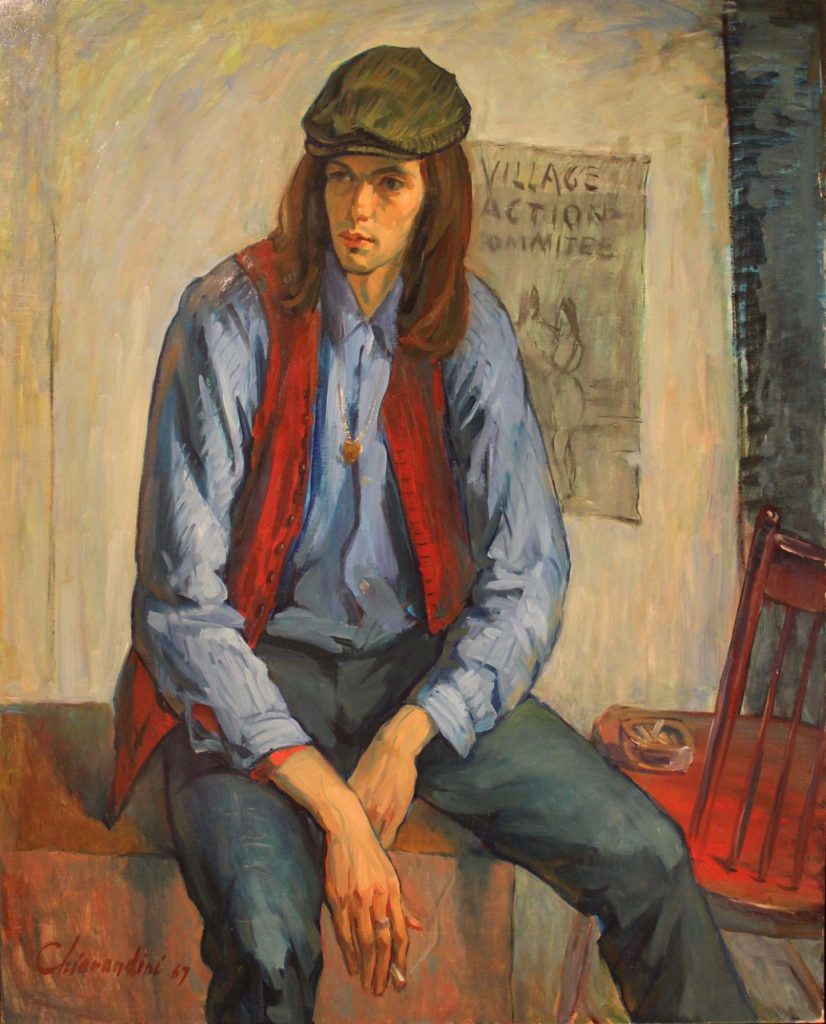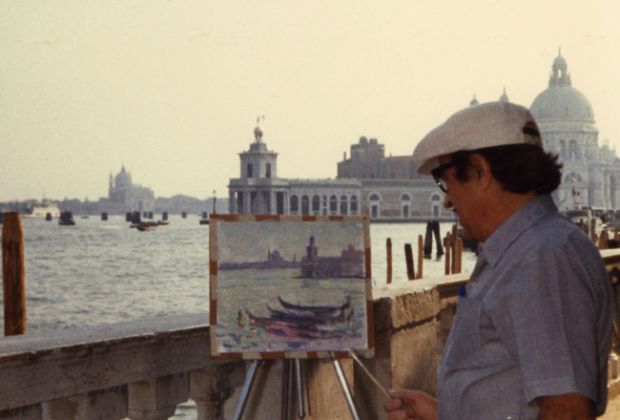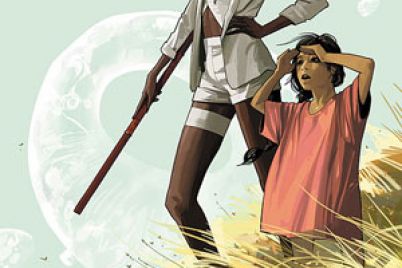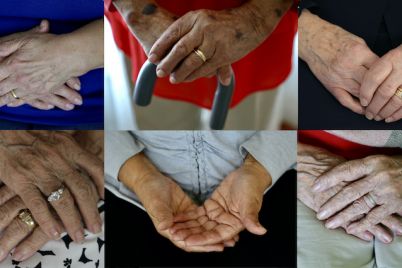The work of Canadian artist Albert Chiarandini will be featured in a special exhibit at the Centaur Gallery in Montreal this fall. The exhibit, titled “Albert Chiarandini Summer of Love – 1967; If You Can’t Remember It You Weren’t There!” will run from September 11th to October 13th. The exhibit will have on display some of the artist’s most famous paintings, which include the “Yorkville hippies.” These works are described as “captur[ing] the integrity of the human spirit” as well as the “faces of political turmoil and the dynamic change.” The deep colours and attention to personality allow the 1960s characters to shine through Chiarandini’s work for a rich visual experience.
Albert Chiarandini was born in Udine, Italy, in 1915 and came to Canada in 1932. He is known for tangible, rural landscapes and honest, colourful portraits that provide a glimpse into the past. Chiarandini studied at the Ontario College of Art and eventually moved to Yorkville, Toronto, where he lived from 1960 to 1971. He passed away in 2007. Award-winning playwright David Fennario will be speaking at the opening on September 11th, 5 to 7 p.m., about his happenstance meeting with Albert Chiarandini in Yorkville in 1967. Click here for more information on the exhibit.
Joan Chiarandini Tadier, Albert’s daughter, agreed to be interviewed by Accenti. The text has been lightly edited for clarity.
***
Your father completed over two thousand pieces in his lifetime. Do you have a particular favourite?
My father was a prolific artist! The Georgina Arts Centre and Gallery in Sutton, Ontario, have 199 of his paintings in their permanent collections; Baycrest Hospital in Toronto has 234 of his paintings; the Joseph D. Carrier Gallery in Toronto has three “hippie portraits” in their permanent collection; as do several other hospitals, institutions and private collections. Impossible to pick one favourite, as he painted beautiful landscapes, huge compositions, flowers, portraits, humble subjects. I love his self-portrait (that will be on exhibit) as well as the portrait of my mother and my nonna (Giovanna). Of course, that is because of my love and connection with them. I love the hippie portraits because I was part of this experience. I was with my dad in Yorkville when he asked me to approach one of the hippies, Chuck Moos, to see if he would pose for my father. What makes this special is that my dad gave me Chuck Moos’s portrait as a gift!
Your father’s paintings have a very distinct style. He has been described as the “unknown member of the Group of Seven.” What do you think earned him this tribute?
My father did study under Franklin Carmichael, a member of the Group of Seven, as a student at the Ontario College of Art. He exhibited his work at many juried exhibitions alongside Franklin Carmichael, A. J. Casson, Frederick Varley and other members of the Group of Seven at the early age of 23! My father was included in the 85th anniversary book, The Group of Seven Project 1920–2005. He loved to paint the countryside, capturing the sky, clouds, sunsets, trees, farm fields, rolling hills, etc. All paintings were done on location. I am not sure what earned him this tribute apart from his exposure to them, and his own distinct style of painting.
Did your father ever say what it was that inspired him to paint?
He was drawing and painting at a very young age. His mother recognized his talent and encouraged it. My father told me he spent every Sunday at the gallery in Udine, Italy, studying the works of the great masters, and this inspired him. He loved Titian. He immigrated to Canada at the age of 16, when he registered to attend the Ontario College of Art.
What were some of his most significant influences?
His teachers John Alfsen, Fredrick Challener, and Franklin Carmichael. Also, the great masters like Titian and Vincent Van Gogh.
How would you sum up his work?
To quote Deborah Saidero in Passion Meets Paintbrush (Forum 2015), “Chiarandini’s art eludes easy labeling or classification. As a migrant subject he was in many ways a ‘translated subject,’ to use Rushdie’s famous definition: a man ‘in between’ cultures, language and artistic tradition; a hybrid individual who, because of his displaced position, was able to view the world around his special eccentric, liminal, outsider gaze and convey the ambiguities and contradictions, the passion and emotions, he saw both outside and within himself.”
In the 1960s your father painted many of the “Yorkville hippies” in Toronto. Why was he drawn to the hippies as subjects?
When my father was not painting a commissioned portrait, he knew he had to keep his hand in form. So he started approaching the street people that hung around the Salvation Army, Allan Gardens, and Scott Mission. Many of these people were pleased to pose for him at his studio at Bloor and Yonge Street in Toronto, as it got them off the streets, especially during the winter months. They also appreciated being paid to do this.

David Fennario by Albert Chiarandini
Some of my father’s students suggested that he check out the interesting “Yorkville” area where the hippies hung out. This was the beginning. I was with my father on Yorkville Avenue when he asked me to approach one of the hippies, Chuck Moos, to be his first subject. He did a series of twelve hippie portraits including Montreal’s now well-known Award-Winning Playwright David Fennario, as well as David’s lifelong partner Elizabeth Johansen. Elizabeth owns her portrait. That is a story in itself! You must attend the vernissage on September 11th a 5 p.m. to hear David speak about this. Both David and Elizabeth will be present.
In the Yorkville area, my father captured the face of political turmoil and the dynamic changes in Yorkville. There, he found a different attitude to record and portray, a driven younger generation full of idealism, equality, and peace. He created a series of portraits of young hippies, transient and searching.
What do you remember most or what do you cherish most about growing up as the daughter of an artist father?
My life revolves around my father and his art. From a young age, I have been sharing my story about my dad. I continue to do this today with much love and passion. Two of the things I cherish: I loved joining my father along with his other artist friends or his students and their families in the countryside and farmland in York Region, and at the pond in Uxbridge. We would play, swim, and picnic, while the artists went off to capture the local scenery on canvas. The other moment I treasure is the dinner hour, when my dad would tell us about his experience that day with the street-person he was painting at the time. We heard their life stories. These stories made an impression on me.
Can you tell us a little about the upcoming exhibit at the Centaur Gallery?
The exhibition will include a series of eight life-size hippie portraits. What is unique about these paintings is the relationship that was formed between David Fennario and Albert Chiarandini when they met in Yorkville in 1967; how this relationship continued and why this exhibition is taking place.
Why is this exhibit especially important?
People must not forget this time period in history and remember the importance of peace, love, and freedom. These hippie portraits are a reminder. This was an era that produced many wonderful talents and political controversies. It is good to know their stories.
***
Albert Chiarandini Summer of Love – 1967; If You Can’t Remember It You Weren’t There!
Vernissage: September 11, 2019, 5:00-7:00 p.m.
Exhibit Dates: September 11 – October 13, 2019
Location: Centaur Theatre and Gallery
453 St. Francois Xavier St.
Montreal, Quebec
Contact gallery for hours: 514-288-3161
Sally Cunningham is an English literature and film student originally from Vancouver, BC. She is currently in her third year at Bishop’s University in Sherbrooke, QC. Sally was the co-editor of the 126th edition of The Mitre.




